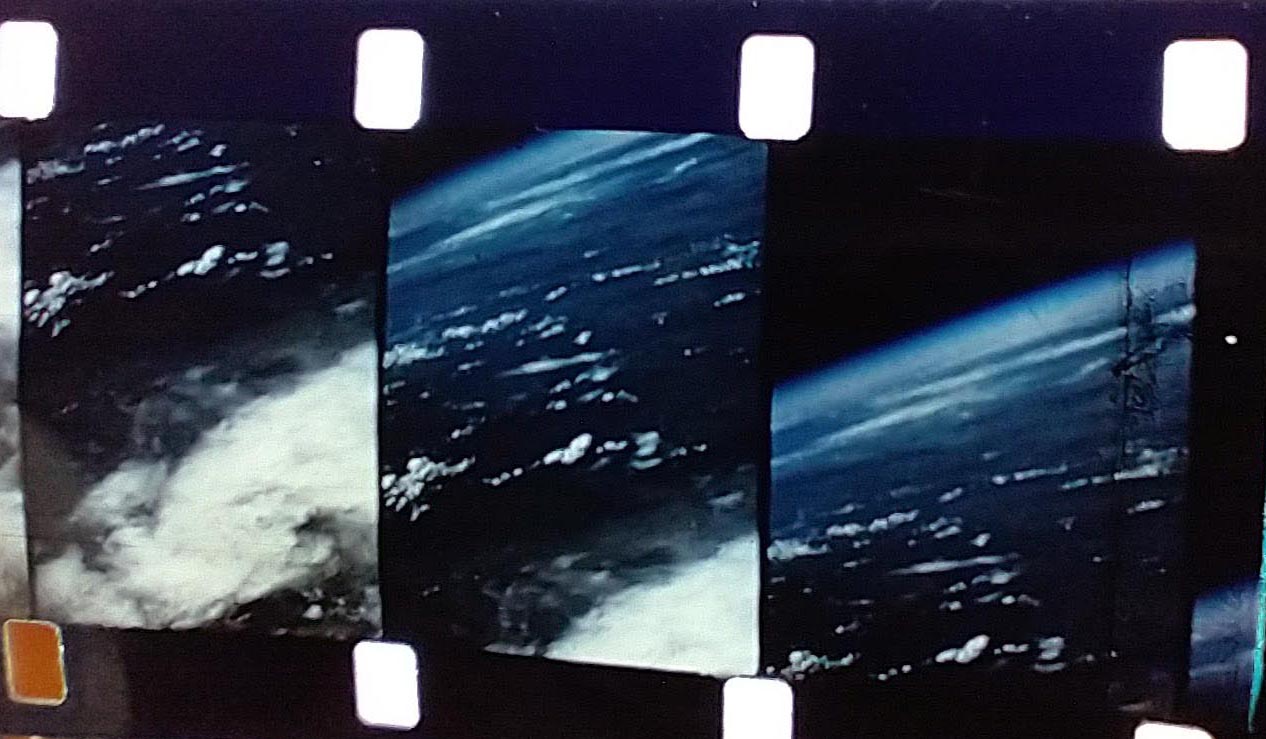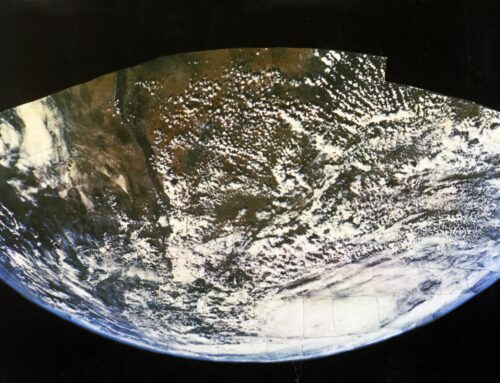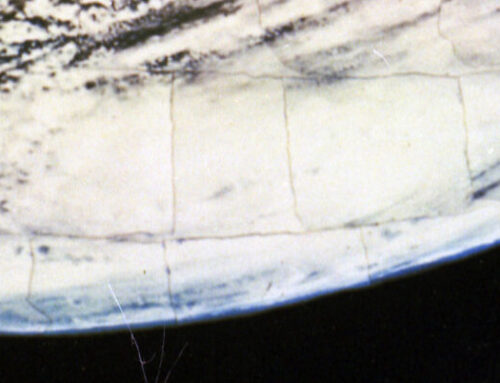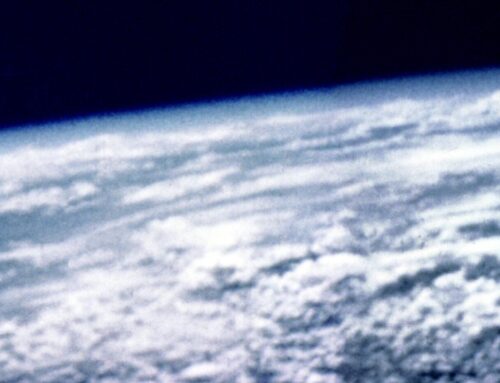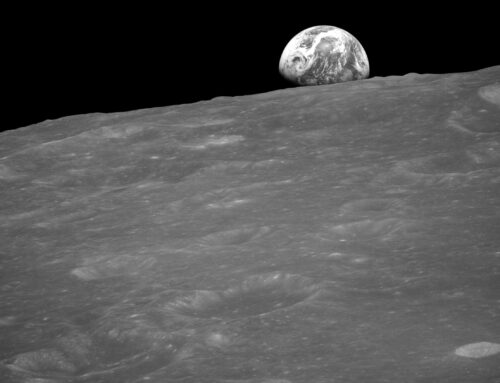First Color Photo of Earth from Space Unearthed!
On October 5, 1954, the Naval Research Laboratory (NRL) launched an Aerobee sounding rocket from the White Sands Proving Grounds in New Mexico. On board were two 16mm movie cameras peering out small holes, one with black and white film and the other with color film.
On that color 16mm film would be recorded the very first color images of Earth from space.
On October 5, 1954, an Aerobee rocket carrying two 16 mm movie cameras (including one with color film) captured the first color images of Earth from space, including images of a tropical storm over the state of Texas. Approximately 140 images from an altitude of 100 miles were used to create this photomosaic of the Earth from space in natural color for the first time.
It is the very record itself of what this planet looks like from space as seen in natural color
When the Aerobee rocket reached its maximum altitude of 100 miles above the Earth, the cameras began filming at a rate of 6 frames per second as the rocket spun, capturing the sweeping vistas of the world below. Upon return to Earth, Dr. Otto Berg of NRL, who had modified the cameras used and oversaw the project, made enlarged prints of the 16mm film frames, using approximately 140 images he carefully cut and assembled to create a montage of the first natural color image of our planet. By happenstance, the images captured a tropical cyclone over Texas moving into the Rio Grande Valley – the first demonstration of the benefits of space photography for tracking hurricanes.
The fully assembled mosaic comprises the first natural color photograph of the Earth from space, with east being to the right, revealing how the Earth would appear to the first astronauts seven years later. The image covers over a million square miles of the south-central US with a tropical storm visible over Texas at lower right of the image. This image also represents the first time the general public saw the Earth from space in natural color, being featured in the September 5, 1955, issue of Life Magazine.
But my connection to and interest in this historical event doesn’t end with a couple of nearly forgotten space history factoids, because on the very day of the completion of my 60th orbit of the sun, it became a part of my own (and Apollospace) history, when I acquired the most wonderful and historically significant item I’ve ever owned: Otto Berg’s 1954 Earth from space 16mm film reels and 35 mm film strips through RR Auctions.
This lot included 3 reels of 16mm film (the original and two copies) as well as 9 35mm negative films strips containing approximately 140 images from the 16mm film that were printed up and used by Berg to create his famous Earth montage.
The Berg Film

Above are some of the first frames of the film. A little background on the nature and advantages of 16mm “safety film”: The revolutionary advantage of 16mm film was that it was “direct reversal” film, meaning the film did not record negatives (to be later processed) during filming, but recorded only the positive camera original. There was no need for the two-step process of creating a negative and then printing a positive later. The film itself was the positive! The “original” positive film would be the film that was actually loaded into the camera and recorded images directly onto it.
The significance of this fact with respect to the Berg film is no less than remarkable and, in my case, providential: the original 16mm film contained in the RR lot is the actual 16mm film that was launched aboard an Aerobee rocket, # AJ 10-24, on October 5, 1954. The rocket carrying the film entered space, reaching a maximum height of 100 miles, recorded on its surface the first color images of Earth from space, returned to Earth and was recovered, became a prized piece in the collection of Dr. Otto Berg, and eventually, 69 years later, made its way to me.

To be clear, the frames of this film record the very first color images of Earth from space in history. The original 16mm film is not a print, copy, duplicate, or facsimile – it is the very record itself of what this planet looks like from space as seen in natural color for the first time. The image below features frames capturing the blue limb of Earth against the black emptiness of space. When I first held and gazed upon this film, the blue hue of the Earth reflected in my eye and was absorbed by my very soul. I’ve never handled any inanimate thing that was more precious or that touched me more profoundly (and I’ve handled some pretty amazing space artifacts over the years!).
The image below shows the location of the first color photograph of the limb of Earth against the blackness of space as it appears on the Berg mosaic.

Location of the first color photographs of Earth’s limb from space as it appears in Otto Berg’s Mosaic
The 16mm film identified and marked as “original” contained in the small tin is in fact the actual original film that recorded the first color images of our planet – and as such is undoubtedly one of the rarest and earliest space flown relics to have ever been held in private hands – preceding human flight into space by some 6 ½ years! There can be no doubt that this is the actual rocket borne film, especially as this labeling is quite distinct from the labeling of the two duplicate copies of 16mm film reels contained in the lot. After nearly 70 years, the first color photograph showing the limb of Earth against the blackness of space is revealed!

I appreciate the significance of owning the Berg film and the honor and responsibility possessing it carries. In short, the film has unequaled historical, scientific, and cultural value. It will be preserved and conserved for the benefit of humanity and the future. It is in remarkably great shape, and I will make sure it remains that way as efforts proceed to properly conserve it. Indeed, the camera that contained this film when it was launched into space on October 5, 1954, is on permanent display in the Smithsonian National Air & Space Museum in Washington DC (along with Berg’s mosaic), displayed alongside one of the 70mm Hassselblad cameras that took the first photograph of Earthrise as seen by the crew of Apollo 8 – a testament to the Berg Film’s significance in the history of space photography. The actual original film that recorded color images of Earth from space for the first time deserves no less acclaim.
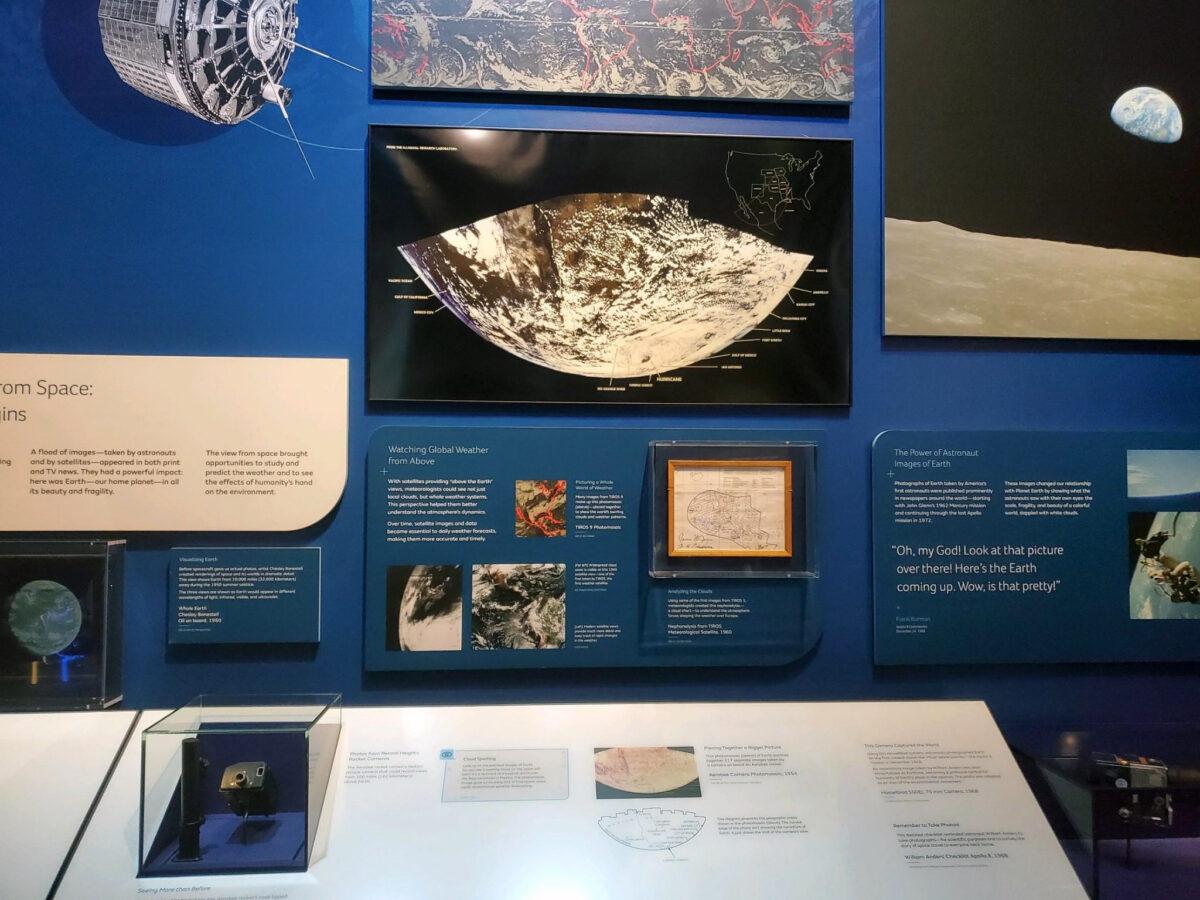
The NRL 16mm camera (lower left) that recorded the Earth film and Berg’s mosaic (center) on permanent display in the Smithsonian Air & Space Museum near the Apollo 8 “Earthrise” camera (right). Photo Credit: Tessa Lillian Endter (Otto Berg’s granddaughter).
In addition to preserving the original film, restoration and conservation of the two copies and 35 mm negatives is also planned. The 35mm negatives that were used to create the prints composing Berg’s photomosaic will be scanned and color corrected as ultra-high resolution digital scans. One of the film copies, believed to be the copy used to create the prints, suffers from mold damage and will also be cleaned and restored. The other film copy, already in excellent condition, will be scanned, with a digital copy produced in the highest resolution possible for accessing individual frames as well as creation of a digital “movie” – in time for the 70th anniversary of the film’s creation in October 2024.

Among the treasures in the Berg film lot were 8 pages of manuscript from Berg’s unpublished autobiography, “Confessions of a Rocket Scientist” detailing the background and challenge of capturing the first color images of Earth from space. That, along with my own research over the last couple of months and various FOIA, archival research, and other requests for information pending, will be a continuing story appearing here and through Apollospace films. For the first time in decades one of the most significant events in the history of space photography will be revealed in detail.

Below are a few excerpts from Berg’s unpublished autobiography, “Confessions of a Rocket Scientist” (copyright Otto Berg, date unknown, excerpted with family permission) detailing the impetus and challenges behind capturing color photographs of Earth from space for the first time:
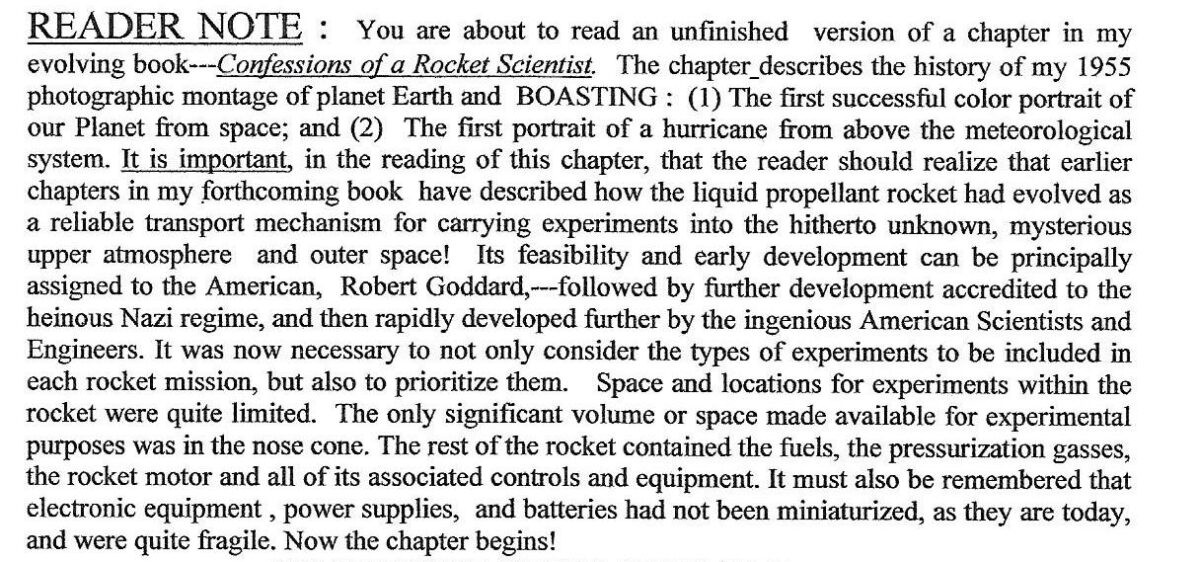
THE 1954 MONTAGE OF PLANET EARTH
In situ experiments of Earth’s upper atmosphere up till this time had been limited to balloon altitudes of around 25 miles, but it was known that the higher altitudes of Earth’s atmosphere and space was teeming with derived and assumed mysteries. With the advent of the liquid propellant rockets this area was now available for exploration. Our team members eagerly contrived a large variety of instruments to reveal the secrets of space.
First b&w photo of the Earth from Space. Image Credit: Department of Defense, Department of the Army 1946
Photography of the Earth, however, was not even listed among those priorities because it was not considered of prime interest toward the resolution of the mysteries of space and thus not an interesting factor to the Astronomer nor the Astrophysicist. However, a member of our Rocket Sonde Branch, Leo Winkler, persuaded one of the payload managers to include a K35 camera as part of the instrumental experiments in a V-2. Mr. Winkler succeeded in obtaining a few black and white exposures of the Earth’s horizon. No Geographic details were detectable, but the photos demonstrated for the first time a very limited segment of the Earth’s’ curvature-horizon, proving that the Earth was round! Wow!!! Every newspaper carried the picture of—“The first photos ever taken showing the Earth’s curvature taken from a rocket!” (refuting forever the argument that the Earth was “flat”).
A later attempt by the Johns Hopkins University to photograph the Earth in color failed. The failure was explained in this way, that —“It will ever be impossible to photograph the Earth in color from outer space due to the haze layer surrounding Planet which serves as a mirror reflecting the sunlight and thus masking the planet’s surface”.
As rocket borne experiments improved and data poured in, there was a need to know not only the altitude of the rocket, but also the exact attitude (vertical and spin positions) of the rocket so that the experimenter could constantly relate the data to the altitude and the viewing angle of the experiment relative to the Sun and/or the Earth’s axis. A simple and accurate solution to these demands came via photography using a 16 mm gun camera equipped with a wide-angle lens and loaded with infra-red film. The film would repeatedly record the relative angle of Earth’s horizon and the position of the Sun —a combination that precisely nailed down the position of the rocket axis to the Sun and the Earth’s axis. That process was called —The Rocket Aspect system. It was a very simple system requiring no significant math nor physics, so I got the job! In addition to that menial position, I had the great privilege of working with Dr. Ralph Havens on his experiments.
Time passed, and strangely, the failure by the Johns Hopkins University to photograph the Earth in color seemed to pose a challenge to me to prove color photography of the Earth was indeed possible. I deliberately/ advisedly use the term ‘strangely” here because at this stage of my professional life I was not that confident of my abilities and certainly not to the degree that I would be so aggressive as to “challenge” the capability of a Johns Hopkins man of science! Nevertheless, I did, indeed, react to a “challenge”!
Our Planet, Earth, has an atmosphere and a significant component of that atmosphere is water vapor providing a “haze layer”. The existence of the haze layer is not noticeable from the perspective of persons on the Earth’s surface looking up, but from the perspective of a Martian looking down at our planet it would appear as a mirror reflecting the Sun’s visible radiation. The reflective characteristics of Earth’s haze layer were well known from numerous earlier studies of the lower atmosphere by ground-based measurements. Through an unsolicited hint (Divine intervention?) I realized that one of the normal photographic filters (Wratten) that I had used in other experimentation seemed to match those of the reflective haze layer characteristics of Earth, providing a filter system that would filter out the unwanted reflections and allow only reflections from the Earth’s surface to be registered on the camera film. —and so, because I was already active in rocket photography via the “Rocket Aspect System” I proposed an experimental photographic ensemble to provide a 16 mm movie film, in color, of the Earth’s surface based on the above considerations.
To my surprise, the proposal was accepted! As I began to ponder my strategy, I realized that there were problems! —Several problems! The black and white Infra-red · film I had been using in the aspect cameras was much faster (more sensitive) than the proposed color films available. Also, in early black and white rocket photography, there was little reason for good photographic resolution or detail because the “aspect system” merely required an image of the brilliant Sun plus a fuzzy line indicating the angle of the horizon. Color photos of the Earth’s surface would require significantly greater detail.
In addition to the need for faster (more sensitive) film was the demands for an associated much faster shutter speed, particularly as taken from a spinning rocket photographing subjects a hundred or more miles away.
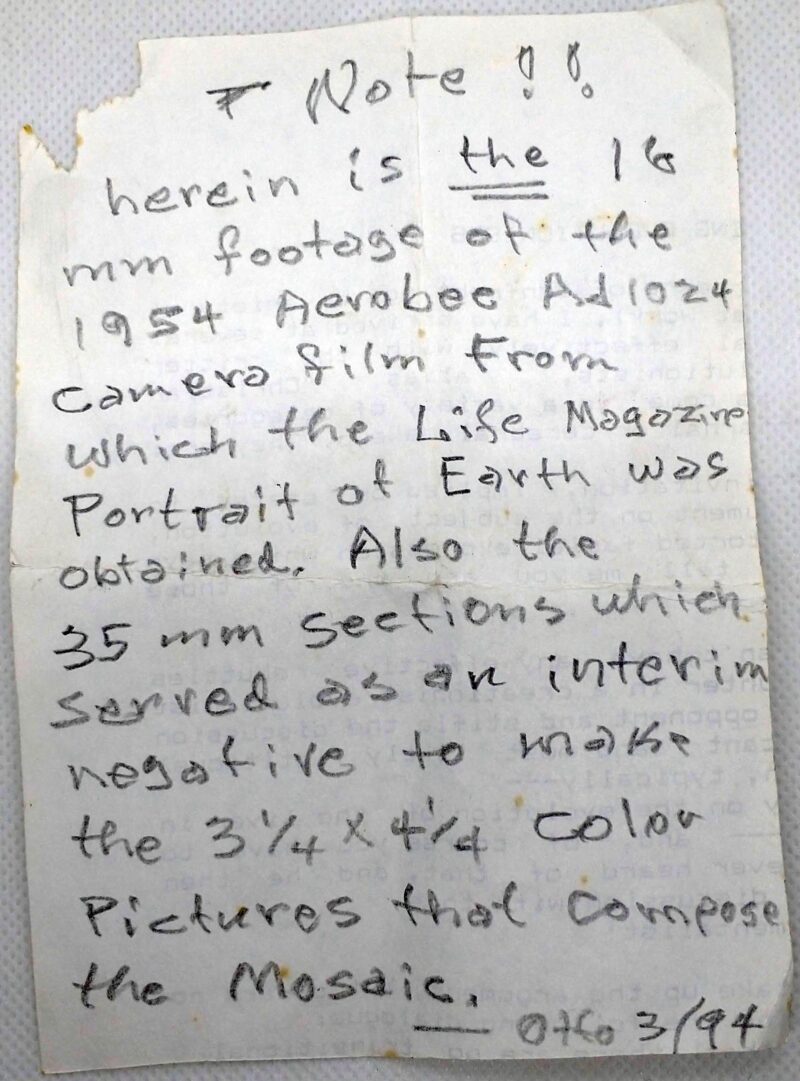
Note by Berg certifying the films

